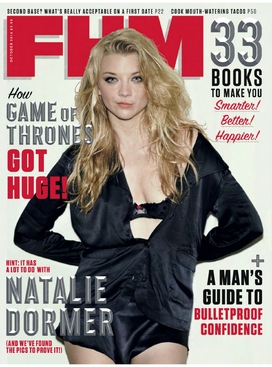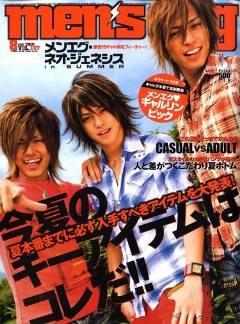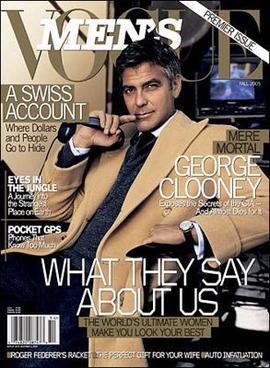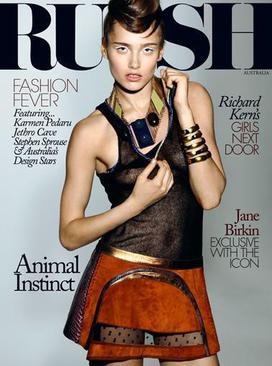Related Research Articles

Fashion is a term used interchangeably to describe the creation of clothing, footwear, accessories, cosmetics, and jewellery of different cultural aesthetics and their mix and match into outfits that depict distinctive ways of dressing as signifiers of social status, self-expression, and group belonging. As a multifaceted term, fashion describes an industry, styles, aesthetics, and trends.

Thomas Carlyle Ford is an American fashion designer and filmmaker. He launched his eponymous brand in 2005, having previously been the creative director at Gucci and Yves Saint Laurent. Ford wrote and directed the films A Single Man (2009) and Nocturnal Animals (2016). From 2019 to 2022 he was chairman of the Council of Fashion Designers of America.

Esquire is an American men's magazine. Currently published in the United States by Hearst, it also has more than 20 international editions.

FHM was a printed British multinational men's lifestyle magazine that was published in several countries. It contained features such as the FHM 100 Sexiest Women in the World.

Issey Miyake was a Japanese fashion designer. He was known for his technology-driven clothing designs, exhibitions and fragrances, such as L'eau d'Issey, which became his best-known product.
Vogue, also known as American Vogue, is a monthly fashion and lifestyle magazine that covers style news, including haute couture fashion, beauty, culture, living, and runway. It is part of the global collection of Condé Nast's VOGUE media.

GQ is an international monthly men's magazine based in New York City and founded in 1931. The publication focuses on fashion, style, and culture for men, though articles on food, movies, fitness, sex, music, travel, celebrities' sports, technology, and books are also featured.

Marie Claire is a French international monthly magazine first published in France in 1937, followed by the United Kingdom in 1941. Since then various editions are published in many countries and languages.

Lolita fashion is a subculture from Japan that is highly influenced by Victorian clothing and styles from the Rococo period. A very distinctive property of Lolita fashion is the aesthetic of cuteness. This clothing subculture can be categorized into three main substyles: 'Gothic', 'Classic', and 'Sweet'. Many other substyles such as 'Sailor', 'Country', 'Hime' (princess), 'Guro' (grotesque), 'Qi' and 'Wa', 'Punk', 'Shiro' (white), 'Kuro' (black), and 'Steampunk' Lolita also exist. This style evolved into a widely followed subculture in Japan and other countries in the 1990s and 2000s and may have waned in Japan as of the 2010s as the fashion became more mainstream.
Gyarupronounced[ɡʲa̠ꜜɾɯ̟ᵝ], is a Japanese fashion subculture. The term gyaru is a Japanese transliteration of the English slang word gal. The initial meaning as a Japanese slang word during the Shōwa era was similar to the English meaning and referred to a young woman in her late teens to twenties. In the early Shōwa period, the term Gyaru was also used in a mocking manner towards young women with a "frivolous" lifestyle.

MensEGG was a style magazine distributed in Japan aimed at young men published between 1999 and 2013. It was a counterpart of Egg magazine, which focused on Gyaru-oh fashions – it was the gyaru-oh bible. There is also Men's Egg Bitter magazine, aimed at Gyaruo aged 23 and above.

Men's Vogue was a monthly men's magazine that covered fashion, design, art, culture, sports and technology. The premier issue was August 2005. On 30 October 2008 Condé Nast announced that they intended to fold the magazine into Vogue proper as a bi-annual subscriber's supplement. However, the magazine has ceased to be published since its original folding date.
Japanese street fashion refers to a number of styles of contemporary modern clothing in Japan. Created from a mix of both local and foreign fashion brands, Japanese street fashions tend to have their own distinctive style, with some considered to be extreme and avant-garde, with similarities to the haute couture styles seen on European catwalks.

Kenzō Takada was a Japanese fashion designer living in France. He founded Kenzo, a worldwide clothing brand, that also markets skin care and perfumes, Takada was the honorary president of the Asian Couture Federation.

InStyle is an American monthly women's fashion magazine founded in 1994. It was published in the United States by Dotdash Meredith, and started originally as a brand extension of People before carving out its own identity. In February 2022, it was announced that InStyle would cease print publications and move to a digital-only format.
Pacific Magazines was a magazine publisher operating in Australia owned by Seven West Media. In March 2020, it was acquired by Bauer Media Australia in April 2020. In June 2020, Mercury Capital acquired Pacific Magazines as part of its purchase of Bauer's former Australian and New Zealand assets.

RUSSH is a quarterly, independent Australian fashion magazine established in 2004. The magazine primarily focuses on fashion, art and music. In 2018, Russh was listed by StyleCaster as one of the "21 International Fashion Magazines That Should Be on Your Radar."

T: The New York Times Style Magazine, known simply as T is a perfect-bound magazine publication of The New York Times newspaper dedicated to fashion, living, beauty, holiday, travel, and design coverage. T is not a supplement of The New York Times Magazine, but a distinct publication with its own staff. It was launched in August 2004, and is distributed with the Sunday edition of the newspaper 11 times a year.
Bara is a colloquialism for a genre of Japanese art and media known within Japan as gay manga (ゲイ漫画) or gei komi. The genre focuses on male same-sex love, as created primarily by gay men for a gay male audience. Bara can vary in visual style and plot, but typically features masculine men with varying degrees of muscle, body fat, and body hair, akin to bear or bodybuilding culture. While bara is typically pornographic, the genre has also depicted romantic and autobiographical subject material, as it acknowledges the varied reactions to homosexuality in modern Japan.
An An is a weekly Japanese women's lifestyle magazine. It is one of the earliest and popular women's magazines in Japan. In 2009 it was described by Japan Today as a mega-popular women's magazine. It is also one of the best-selling women's magazines in the country.
References
- ↑ "The Current State of Japanese Fashion and Lifestyle Magazines". Minimal. JP. 3 June 2013. Archived from the original on 17 March 2016. Retrieved 16 September 2016.
- ↑ "Huge Magazine". Virtual Japan. Retrieved 8 July 2015.
- ↑ "10 Japanese Men's Style Magazines". Complex. Retrieved 24 April 2016.
- ↑ "Huge". Fashion Model Directory. Retrieved 16 September 2016.